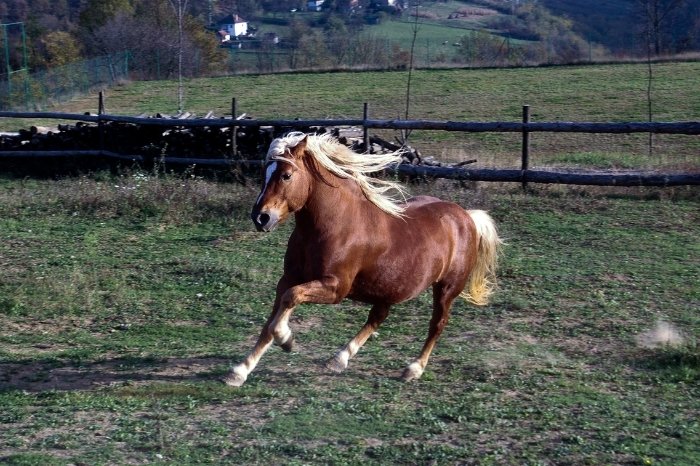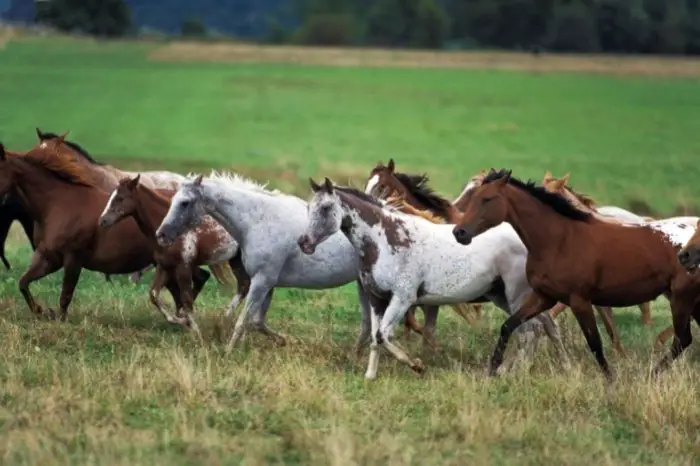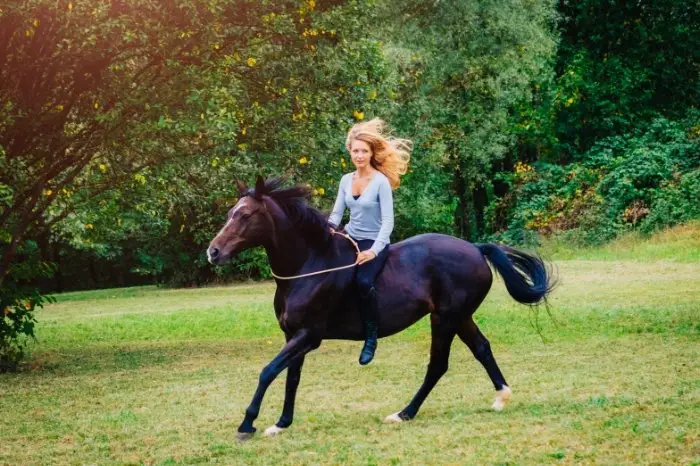Last Updated on February 19, 2022
Horses are incredibly athletic animals with a variety of different paces that enable them to cover the ground efficiently. The difference between trot and canter involves the order in which the horse moves its legs, as well as how quickly he covers the ground. Let’s find out more about the paces of the horse!
Trotting And Cantering Explained
Horses have evolved to travel and move at a number of different paces. Most horses have four basic gaits – walk, trot, canter, and gallop. Some horses have an extra or alternative gait, and these are called gaited horses.
The difference between each gait lies in the order in which the legs are moved, as well as whether the legs are moved at the same time or on their own.
Let’s take a look at each gait in detail:
Walk
The slowest pace of the horse, the walk is a low-effort gait that expends minimal energy. At the walk, the horse moves each leg in turn, which makes this a four-beat movement.
Trot
At the trot, the horse moves its legs together in diagonal pairs. It will move the right fore leg at the same time as the left hind leg, and vice versa. This give a two-beat movement, with a moment of suspension where all four hooves are in the air at the same time.
Canter
The canter is a three-beat movement that has a distinctive ‘moment of suspension’ where all four legs are simultaneously off the ground. At this pace, the horse propels its whole body forward in a bounding motion, using a single hind leg. The other hind leg and opposite fore leg then move forward, followed by the other fore leg.
Gallop
The gallop is the fastest of all horse gaits. At the gallop, the legs move in the same order as the canter, but the paired diagonal legs land on the ground separately. This means that the gallop is a four-beat movement.

Gaited Horses
Whilst most horses naturally have four gaits, some have an extra or alternative gait. Many breeds of horse are naturally gaited, whilst others can be taught to move at a new gait.
Examples of gaited horses and their movement include:
-
The Tennessee Walking Horse
This spectacular breed of horse has a fascinating high-stepping four-beat running walk gait.
-
Missouri Fox Trotter
The Missouri Fox Trotter has an adaptation of the standard trot gait, where the front foot of each diagonal pair lands before the hind.
-
American Saddlebred
This breed can be taught many different gaits, including a four-beat high-stepping running walk, and a high-speed ambling gait called the rack.
Kentucky’s Saddlebred Heritage (KY) (Images of America)
What Is The Difference Between Trot And Canter?
The difference between trot and canter is that trot is a two-time gait, whilst canter is a three-time gait. At the trot the horse moves opposite diagonal pairs of legs, giving short strides around three feet in length that cover the ground efficiently. This is a bouncy movement for the rider, who must learn to post (rise) in time with the movement.
Canter is a rolling movement, where the horse moves forward in large strides that are around 12 feet long. At a canter the horse can accelerate quickly, enabling it to flee from any potential threats. This is also the most comfortable pace for a horse to use when approaching a jump.
Trot Vs Canter – Which Is Fastest?
When it comes to the difference in speed of trot and canter, there are many variables we need to take into account. Both of these paces can be either very slow or fast, depending on the stride length of the horse. Trot is generally a slower pace than canter, but a fast trotting horse can overtake a slow cantering horse!
The average speed of a horse at trot is 8 miles per hour, and the horse can maintain this pace comfortably for long distances. The average speed of a canter is from 10 to 17 miles per hour. However, the canter pace requires much more energy, and the horse will need to be very fit to canter for long distances.

Canter Vs Trot – Which Is Easier To Ride?
When learning to ride, both the trot and canter can be quite a challenge! The difference between trot and canter is the effect that these gaits have on the movement of the horse, and therefore the rider too.
The two-time diagonal trotting movement has a fast, jolting action which feels very different to the smooth walking movement! The rider will need to learn to move in time to this bouncing action.
This is why many riders carry out an action called rising or posting trot, where they lift their upper body up and down in time with the trotting movement. Learning to post can be difficult at first, but will soon become more comfortable. You can then go on to perfect the sitting trot, where you absorb the bouncing movement through your body.
Canter is dramatically different to trotting for the rider. This gait has long strides with a bounding action, which can be unbalancing for the novice rider. It can take time to learn to maintain your balance at the canter, but once this is mastered you will find this gait very comfortable.
To ride a horse at canter, you will need to keep your upper body balanced with the movement of the horse. For this you need a deep and secure seat, to avoid being bounced out of the saddle.

Summary
So, as we have learned, the difference between trot and canter is that trot is a two-time pace that enables the horse to cover long distances with minimal energy use. The canter is a faster pace but uses more energy, and cannot be sustained for long distances. These are both difficult paces for the rider to learn, as they create a rocky movement that causes the rider to lose balance.
We’d love to hear your thoughts on the difference between trot and canter! Did you find it difficult to learn to ride at a trot? Or maybe you’ve got questions about how to canter on your horse? Leave a comment below and we’ll get back to you!

Kate Chalmers is a qualified veterinary nurse who has specialized in horse care for the vast majority of her career. She has been around horses since she was a child, starting out riding ponies and helping out at the local stables before going on to college to study Horse Care & Management. She has backed and trained many horses during her lifetime and competed in various equestrian sports at different levels.
After Kate qualified as a veterinary nurse, she provided nursing care to the patients of a large equine veterinary hospital for many years. She then went on to teach horse care and veterinary nursing at one of the top colleges in the country. This has led to an in-depth knowledge of the care needs of horses and their various medical ailments, as well as a life-long passion for educating horse owners on how to provide the best possible care for their four-legged friends.
Kate Chalmers BSc (Hons) CVN, Dip AVN (Equine) Dip HE CVN EVN VN A1 PGCE

